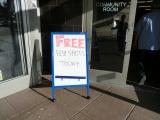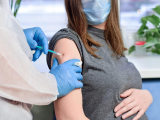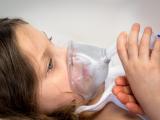Oct 28, 2004 (CIDRAP News) – The United States was on track to provide 100 million doses of influenza vaccine this year when half of its supply was withdrawn in early October because of contamination concerns over vaccine from Chiron Corp. Suddenly about 48 million doses shy of the expected supply, US officials scrambled to define priorities.
Trying to cut the demand to fit the supply, the Centers for Disease Control and Prevention (CDC) recommended that most healthy people between ages 2 and 64 forgo the shots so they can be reserved for those at high risk for serious flu complications. At last report, the nation is expected to have a total of about 61 million doses of vaccine this season, as compared with 83 million doses used last year.
The unprecedented shortage poses a major challenge to the healthcare system across the country as officials strive to ensure that the most vulnerable people get their shots. To monitor how the system is responding, CIDRAP News will run occasional stories focusing on reactions to the shortage in five states: California, Colorado, Florida, Minnesota, and New York.
For now, states are trying to follow the CDC guidelines for vaccinating high-risk people, although whether to vaccinate healthcare workers has been debated in some places. Some states are encouraging vaccination with the live-virus intranasal vaccine FluMist for healthcare providers as a way to conserve injectable vaccine for high-risk people. Some states, such as Colorado and California, have taken a page from pandemic flu plans to conduct large-scale immunization clinics for qualifying patients.
California: Who has vaccine?
In California, officials are trying to determine where private-sector vaccine distribution is taking place and parceling out the state's meager vaccine supply.
The California Department of Health Services had ordered its entire supply of 573,000 doses of vaccine from Chiron, the lowest bidder, said Nisha Gandhi, an adult immunization coordinator for the department. When the Chiron deliveries were canceled, the state had to get in line with others for vaccine.
So far, California's health department has given 234,560 doses of vaccine to local health departments, primarily for low-income children and qualifying patients in Medi-Cal or the Child Health and Disability Prevention Program, according to a news release. Health officials announced on Oct 21 that the state had received another 271,740 doses of vaccine to distribute to local health departments for high-risk patients.
The total supply of 506,300 doses has to be distributed among the estimated 11,869,000 Californians who should be vaccinated under the CDC guidelines, Gandhi said. That's a third of the state's population.
Aventis Pasteur, the remaining US supplier of injectable vaccine, has released some general distribution data. Officials are using it to ascertain where the private doses are and to whom they'll be distributed, Gandhi said.
"We're trying to combine that with what's been delivered to determine what needs are being met," she said.
"We know through different population-based surveys that most people get their vaccine through their providers and not through the public [health system]," Gandhi said. "The big question is: How much private-sector vaccine is out there? It's extremely difficult to tell."
Colorado: A change of plans
Colorado was to distribute free flu vaccine to anyone who wanted it as part of a massive, nine-county bioterrorism drill on Oct 16. Instead, only those at high-risk were injected, according to news releases from the state health department. Close to 8,000 people received shots during the exercise, the department said.
Florida: Hospitals feel shortage
In an Oct 26 letter to the St. Petersburg Times, infectious disease chiefs from three Florida universities asked federal officials to declare a national emergency and recall available vaccine supplies for redistribution to the neediest.
One of the writers was Frederick Southwick, MD, vice chairman of medicine and chief of the division of infectious diseases at the University of Florida College of Medicine.
Southwick told CIDRAP News his hospital had ordered 13,000 doses of vaccine. "We got none," he said. If 50% of the vaccine supply is gone, he reasoned, he should receive about 6,500 doses.
The 600-bed hospital at the university is part of Shands HealthCare System. It has a high proportion of transplant patients, for whom a bout with the flu is particularly dangerous, Southwick said. The hospital usually vaccinates 600 transplant recipients each season.
Suddenly, transplant recipients who couldn't find flu shots elsewhere were calling the hospital, he said. More than 1,200 of the vulnerable patients have asked for the vaccine.
Although the hospital hasn't yet received any vaccine, Southwick said officials have determined whom they will vaccinate if they can: Transplant recipients will have priority over elderly patients with severe underlying diseases.
Choosing among patients was "very disturbing to me," Southwick said. No hospital workers will be vaccinated.
In Gainesville, the flu season usually ratchets up after Thanksgiving and peaks around New Year's, Southwick said. "We still have time," he said. "We're hoping."
Minnesota: 377,000 doses short
A Minnesota Department of Health survey last week indicated that the state was short about 377,000 doses of vaccine, according to the Associated Press (AP). The department has urged companies to vaccinate only high-risk employees and to share leftover vaccine.
Minnesota's largest flu-shot provider said this week it had obtained 81,500 doses of flu vaccine, according to the AP. The nonprofit Minnesota Visiting Nurse Agency said it would vaccinate those at high risk for $16 each. Of the doses the agency has on hand, 68,000 came from the national Visiting Nurse Associations of America and 13,500 from Supervalu, Inc., a grocery wholesaler.
New York: An appeal for donations
New York City Mayor Michael Bloomberg and the state health commissioner on Oct 26 asked area employers and providers to donate vaccines to those at high risk. The state health department is seeking another 600,000 doses for high-risk New Yorkers, according to wire services.


















